The thesis proposes the creation of a simulation and prediction platform integrating Building Information Modeling (BIM) and artificial intelligence (AI) to answer its research question and achieve its objectives. This multifunctional platform will be developed in several stages, starting with the retrieval of data from a BIM model as a basis for carrying out various automated simulations via algorithms. These simulations aim to optimize energy consumption and reduce environmental impact. A key challenge lies in integrating data from different simulations (energy and lifecycle analysis) into a common database, and displaying the results on an interactive dashboard to facilitate optimal decision-making without the need to repeat simulations. The user interface will be interactive, allowing alternative scenarios to be explored with the AI and results to be exported in the desired format.
This approach aims to save design time and improve decision-making, addressing both environmental and economic aspects. The platform will evolve with research, and can integrate other sustainability parameters and development tools. It will serve as a basis for future research in the same context. As far as practical results are concerned, this is the prototype of the platform under development. The platform would meet specific needs defined during the collaboration with SQI. The prototype will also be evaluated and validated on real projects. However, development of the platform could be advanced in the next stages. This solution could be adopted by the various stakeholders in general, and by public-sector contractors in particular. It is open-ended and allows the addition of new sustainability concepts such as the integration of the circular economy, biodiversity and GHGs, among others.
The research aims to explore the link between Building Information Modeling (BIM) and sustainability, highlighting the lack of practical applications in existing, mostly theoretical studies. The artifact developed tackles multi-criteria optimization for sustainability, a challenge taken up by several authors. The prototype platform offers a solution for multi-criteria analysis, facilitating trade-offs between different aspects of sustainability and enabling future improvements through the integration of new concepts. The main objective is to improve the sustainability of the built environment, with a focus on energy efficiency and environmental impacts, thus responding to climate issues. The proposed tool aims to support stakeholders in early decision-making, improving life-cycle outcomes and justifying trade-offs for sustainability. The platform offers an economic and environmental approach, using artificial intelligence to evaluate various scenarios, reducing the complexity and cost of multi-criteria analysis, while encouraging the adoption of innovative technologies.



